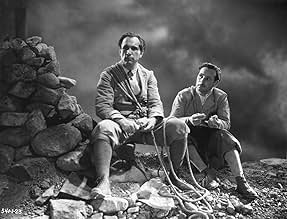Ajouter une intrigue dans votre langueDuring World War 1, an Austrian Battalion holds a mountain stronghold against the attack of the Italian army.During World War 1, an Austrian Battalion holds a mountain stronghold against the attack of the Italian army.During World War 1, an Austrian Battalion holds a mountain stronghold against the attack of the Italian army.
- Réalisation
- Scénario
- Casting principal
- Récompenses
- 1 victoire au total
Herman Bing
- Austrian Soldier
- (non crédité)
Paul Panzer
- Villager
- (non crédité)
Russ Powell
- Burgermeister
- (non crédité)
Avis à la une
Luis Trenker loves climbing the Dolemites in Italy, but when World War One breaks out, he returns home to Austria Hungary, where he is assigned to a mountain fort. Soon it becomes the scene of a battle, where his old friend, Albert Conti, is ordered by the Italian high command to take the fort.
It's one of those movies that was made in three versions, one in French, one in German and this English-language version, the only one known to survive. It has all the markings of a Mountain Movie, with lots of beautiful pictures of snow-covered mountains. It also shows it's joins clearly, with lots of wild shots between staged scenes, and a lot of looping in the dialogue for people to talk.
Viewed as a visual effect, it is quite lovely, with DP Charles Stumar making the bleak mountains lovely, and lithely moving the camera to maintain composition in the story scenes. However, the two parts of the movie seem disjoint, and never quite come together.
It's one of those movies that was made in three versions, one in French, one in German and this English-language version, the only one known to survive. It has all the markings of a Mountain Movie, with lots of beautiful pictures of snow-covered mountains. It also shows it's joins clearly, with lots of wild shots between staged scenes, and a lot of looping in the dialogue for people to talk.
Viewed as a visual effect, it is quite lovely, with DP Charles Stumar making the bleak mountains lovely, and lithely moving the camera to maintain composition in the story scenes. However, the two parts of the movie seem disjoint, and never quite come together.
Back in the late 1920s and early 30s, Hollywood was at the forefront of film making, as they had switched to sound years before the rest of the world and their films were very popular overseas. But that brought a problem...how do you get these folks in other countries to watch a film made in English? During the silent years, it was easy...just create alternate intertitle cards. But after sound, they did not have dubbing technology...so studios like MGM (with their Laurel & Hardy pictures) and Universal (with "Dracula") made two, three or even more versions of the same movie in different languages. In the case of Laurel & Hardy, they learned to deliver their lines phonetically....and they really sound like they have no idea what they are saying in some of the films. With "Dracula", many of the supporting characters were kept and delivered lines phonetically and they brought in a new leading man to play the Count!
I mention this because "The Doomed Battalion" also is one of these films with alternate versions. I watched the English language version, but Universal also made a German and French language version. It makes sense to make one in German, as the film is very sympathetic towards the Austrians and is told from their viewpoint.
That also brings up another interesting trend in films at that time. The American's former enemies during WWI were now being treated sympathetically in movies...such as in this, "Ever in My Heart", "Four Sons" and "All Quiet on the Western Front". This is because during the 1920s and into the 30s, America began re-assessing our part in WWI and slowly many Americans came to realize that we had no business in the war AND that the formerly hated Germans and Austrians were really no different that our French and British allies...as this war was very much unlike WWII, where the good guys and bad guys were obvious.
The film begins just before WWI and is set in the Tyrol--the land occupying parts of Austria and Italy where the Dolemites and Alps are found. Soon, war begins and Italy declares war on Austria-Hungary*. Soon the peaceful mountain villages are in turmoil...and the film paints the Italians as the aggressors in this pointless war.
Although I liked the subject matter of the film (after all, I cannot recall another American film to cover this same material), the story itself is lacking. Instead of there being a coherent plot and characters, the film mostly came off like a long string of archival silent footage and small scenes all strung together with music and sound effects...with a bit of dialog added. You never really get to know and love characters like you do in "All Quiet on the Western Front" and the dead and living just seem interchangeable. An interesting topic...just not the best presentation of this material...and the whole 'doomed battalion' aspect only makes up the latter portion of the movie. Because of this, it's worth seeing but probably won't be appreciated by folks who don't love history and understand the time and setting.
*Austria was Austria-Hungary during WWI and was divided following the war. Also, at the beginning of WWI, Italy was part of the Central Powers (which included Germany and Austria-Hungary)...but soon switched sides in order to take the Dolemites from the Austria-Hungarian Empire. And, sadly, there were approximately 4.5 million casualties in this part of the war...all for some mountains and a bit of land.
I mention this because "The Doomed Battalion" also is one of these films with alternate versions. I watched the English language version, but Universal also made a German and French language version. It makes sense to make one in German, as the film is very sympathetic towards the Austrians and is told from their viewpoint.
That also brings up another interesting trend in films at that time. The American's former enemies during WWI were now being treated sympathetically in movies...such as in this, "Ever in My Heart", "Four Sons" and "All Quiet on the Western Front". This is because during the 1920s and into the 30s, America began re-assessing our part in WWI and slowly many Americans came to realize that we had no business in the war AND that the formerly hated Germans and Austrians were really no different that our French and British allies...as this war was very much unlike WWII, where the good guys and bad guys were obvious.
The film begins just before WWI and is set in the Tyrol--the land occupying parts of Austria and Italy where the Dolemites and Alps are found. Soon, war begins and Italy declares war on Austria-Hungary*. Soon the peaceful mountain villages are in turmoil...and the film paints the Italians as the aggressors in this pointless war.
Although I liked the subject matter of the film (after all, I cannot recall another American film to cover this same material), the story itself is lacking. Instead of there being a coherent plot and characters, the film mostly came off like a long string of archival silent footage and small scenes all strung together with music and sound effects...with a bit of dialog added. You never really get to know and love characters like you do in "All Quiet on the Western Front" and the dead and living just seem interchangeable. An interesting topic...just not the best presentation of this material...and the whole 'doomed battalion' aspect only makes up the latter portion of the movie. Because of this, it's worth seeing but probably won't be appreciated by folks who don't love history and understand the time and setting.
*Austria was Austria-Hungary during WWI and was divided following the war. Also, at the beginning of WWI, Italy was part of the Central Powers (which included Germany and Austria-Hungary)...but soon switched sides in order to take the Dolemites from the Austria-Hungarian Empire. And, sadly, there were approximately 4.5 million casualties in this part of the war...all for some mountains and a bit of land.
Le saviez-vous
- AnecdotesThe premiere of "Doomed Battalion" was at the Rivoli theatre in New York on 11 June 1932 (New York Evening Post, 11 June 1932)
- ConnexionsAlternate-language version of Berge in Flammen (1931)
Meilleurs choix
Connectez-vous pour évaluer et suivre la liste de favoris afin de recevoir des recommandations personnalisées
Détails
- Durée1 heure 21 minutes
- Couleur
- Rapport de forme
- 1.20 : 1
Contribuer à cette page
Suggérer une modification ou ajouter du contenu manquant




















